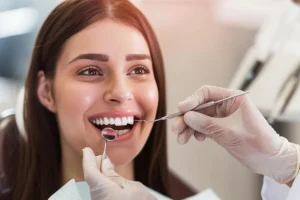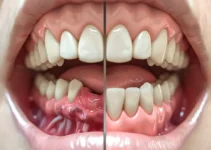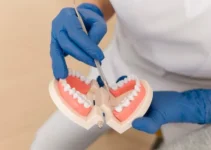Gummy smile botox is a revolutionary approach in cosmetic dentistry, offering a minimally invasive solution for those who are self-conscious about excessive gum exposure when they smile. The procedure involves the careful injection of botulinum toxin into specific facial muscles, which helps in reducing the upward movement of the upper lip, thereby minimizing gum visibility. This treatment not only enhances aesthetic appeal but is also quick, with minimal discomfort and no significant downtime, making it an ideal choice for improving smile aesthetics efficiently.
Understanding Gummy Smiles
A gummy smile, also known as excessive gingival display, is a condition where an abnormally large amount of gum tissue is visible when a person smiles. This can affect one’s self-confidence and social interactions. Understanding the causes and effects of gummy smiles is essential for determining appropriate treatment options.
In this section, we will explore what constitutes a gummy smile, the various causes behind it, and its impact on an individual’s self-esteem. By gaining a deeper insight into these aspects, we can better appreciate the significance of addressing this dental concern.
What is a Gummy Smile?
A gummy smile occurs when there is an excessive display of gum tissue upon smiling. Generally, a smile is considered “gummy” if more than 3-4 millimeters of gum tissue is visible. Although the condition is often purely aesthetic, it can affect individuals’ overall appearance and confidence.
From a clinical perspective, a gummy smile can result from several anatomical variations. These may include short upper lips, hyperactive upper lip muscles, excessive gingival tissue, or the vertical overgrowth of the upper jaw. Each of these factors contributes to the overall visibility of gums during a smile.
Causes of Gummy Smiles
The causes of gummy smiles are diverse and often multifactorial. Some of the primary causes include:
- Genetics: Family history can play a significant role, as certain inherited traits influence the relative proportion of gum tissue visible.
- Abnormal Dental Eruption: This occurs when teeth do not fully erupt, leaving excess gum tissue covering the teeth.
- Hyperactive Upper Lip Muscles: Some individuals have upper lip muscles that contract more than usual, pulling the lip higher and revealing more gum tissue.
- Vertical Maxillary Excess: This is a skeletal condition where the upper jaw grows longer than average, leading to increased gum display.
Understanding the specific cause of a gummy smile in a patient is crucial for selecting the most effective treatment approach.
Impact on Self-Esteem
The psychological impact of a gummy smile should not be underestimated. For many individuals, an excessive gingival display can be a source of significant self-consciousness, affecting their willingness to smile, laugh, or engage in social situations. Self-esteem issues related to a gummy smile can be profound. Studies have shown that people with excessive gingival display are more likely to experience social anxiety and lower confidence levels. This can have cascading effects on personal relationships and professional interactions. Seeing a dental professional for an evaluation and discussing potential treatment options can dramatically improve a patient’s quality of life, enhancing not only their smile but also their overall sense of well-being.
Understanding these aspects encourages readers to explore more about dental health. Feel free to read other articles to deepen your knowledge further.
Botox as a Solution for Gummy Smiles
A gummy smile, medically known as excessive gingival display, can be a source of self-consciousness for many individuals. Traditionally, surgical procedures were the primary method for addressing this cosmetic concern. However, with the advent of modern techniques, options like Botox have emerged as a viable, less invasive alternative. Botox, or Botulinum toxin, offers a promising solution for those looking to improve their smile without undergoing surgery.
In recent years, the application of Botox in dental and facial aesthetics has gained popularity due to its minimal recovery time and effectiveness. Dentists and specialists in facial aesthetics use precise injections to achieve desired results, making it possible to tailor treatments to individual needs. This technique has not only been praised for its efficacy but also for the significant improvement it brings to patients’ confidence and overall quality of life.
How Botox Works for Gummy Smiles
Botox works by targeting the muscles that are responsible for the elevation of the upper lip. When Botox is injected into specific areas, it temporarily weakens these muscles, reducing the upward pull on the lip and covering more of the gums when smiling. The process involves:
- Identifying the hyperactive muscles responsible for the excessive gingival display.
- Using a small needle to inject Botox into those muscles.
- Adjusting the dose and injection sites to customize the treatment for the individual patient.
The procedure is quick and relatively painless, often taking no more than 10-15 minutes to perform. Results begin to appear within a few days, and the full effect is usually visible within two weeks. The effects of Botox injections for gummy smiles typically last between 3 to 6 months, after which the procedure can be repeated.
Studies have shown that Botox can be a safe and effective treatment for gummy smiles when administered by a trained professional. It is essential to consult with a specialist who has experience in both dental and facial anatomy to ensure optimal results and minimize potential risks.
Benefits of Using Botox
Opting for Botox as a treatment for gummy smiles offers several notable advantages over traditional surgical methods. Some of these benefits include:
- Non-invasive treatment: Unlike surgery, Botox does not involve cutting or repositioning tissues, which means there is no need for general anesthesia or lengthy recovery times.
- Minimal downtime: Patients can return to their normal activities immediately after the procedure, with little to no recovery period required.
- Reversible effects: As the effects of Botox are temporary, patients have the flexibility to decide whether they wish to continue with treatments in the future or explore other options.
Moreover, Botox treatments can be precisely tailored to each individual, allowing for a customized approach that addresses the unique anatomical concerns and aesthetic goals of the patient. This personalized treatment plan ensures that the results are both natural-looking and flattering.
For many patients, the psychological benefits of undergoing Botox treatments for gummy smiles are just as significant as the physical improvements. By enhancing their smile, individuals often experience a boost in self-esteem and confidence, enabling them to engage more freely in social and professional interactions.
Ready to explore more about cosmetic dentistry and the various treatment options available? Check out our other articles to learn how modern dental techniques can help you achieve the smile of your dreams.
The Procedure and Aftercare
Dental implants have revolutionized the way we approach tooth replacement. This procedure offers a long-term solution for missing teeth and has become increasingly popular over the years. Understanding the procedure and the necessary aftercare is crucial for achieving the best possible outcome.
In this section, we will outline what you can expect during the dental implant procedure and provide a comprehensive guide on aftercare to ensure optimal results.
What to Expect During the Procedure
The dental implant procedure can vary depending on individual needs but generally follows a structured process. Initially, a comprehensive diagnostic evaluation is carried out, including X-rays and possibly CT scans, to determine the best implant placement.
During the surgery, a titanium post is surgically inserted into the jawbone. This post acts as a root for the artificial tooth. The process typically involves the following steps:
- Administering local or general anesthesia to ensure comfort.
- Making an incision in the gum to expose the bone.
- Drilling a hole into the bone and inserting the titanium post.
- Closing the gum tissue over the implant.
Post-surgery, a period of osseointegration follows, where the jawbone integrates with the titanium post. This crucial phase, which can last several months, ensures the implant is securely anchored.
Aftercare and Results
Proper aftercare is essential to the success of a dental implant. Immediately following the procedure, patients might experience common symptoms such as swelling, bruising, minor bleeding, and discomfort. These can usually be managed with pain medications and cold compresses.
To promote healing and reduce complications, consider the following aftercare tips:
- Avoid hard or chewy foods for a few days.
- Maintain oral hygiene but avoid the surgical site while brushing.
- Refrain from smoking and drinking alcohol, as they can impede healing.
- Attend all follow-up appointments for monitoring and professional cleaning.
The final results of a dental implant can take several months to fully materialize. Once the osseointegration phase is complete, a custom-made crown is attached to the titanium post, restoring full function and aesthetics. The result is a natural-looking, durable replacement that can last a lifetime with proper care.
For more detailed information on dental implants, including cost, benefits, and comparisons with other tooth replacement options, explore our other articles. Understanding every aspect can help you make an informed decision tailored to your needs.
Common Questions About Treating a Gummy Smile with Botox
If you’re considering non-surgical methods to improve the appearance of a gummy smile, you might have questions about the effectiveness and safety of using Botox. Here are some frequently asked questions that might help you understand this cosmetic procedure better.
How can Botox help reduce a gummy smile?
Botox works by temporarily reducing muscle activity. When injected into specific muscles responsible for lifting the upper lip, it relaxes them, preventing them from retracting too far above the teeth when smiling. As a result, less gum tissue is exposed when you smile. This treatment offers a quick and minimally invasive option to achieve a more balanced and proportionate smile.
Is Botox for a gummy smile safe and how long does it last?
Botox injections are generally considered safe when performed by experienced professionals, and the procedure has a good safety track record in cosmetic applications. However, as with any medical treatment, there can be some risks, which your specialist can discuss with you. The effects of Botox treatment typically last around three to four months. After this period, repeat treatments are needed to maintain the smile aesthetics.

My name is Salman Kapa, a 73-year-old expert in bone regeneration and dental implantology. With decades of experience in the field, I am dedicated to advancing our understanding of oral health and hygiene. Through my research and writing, I aim to contribute to the development of innovative solutions in dental care.




